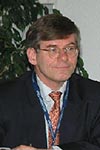Day 1 :
Keynote Forum
Glenn S Tillotson
Cempra Pharmaceuticals, USA
Keynote: The burden of antibiotic resistance
Time : 09:10-09:40

Biography:
Glenn S Tillotson has over 30 years pharmaceutical experience in pre-clinical and clinical research, commercialization, medical affairs, scientific communications including publication planning strategic drug development, life cycle management and global launch programs. He has been instrumental in the development and launch of ciprofloxacin, moxifloxacin, gemifloxacin, fidaxomicin and several other agents. He is a SVP of Medical Affairs where he is preparing for the launch of solithromycin for community acquired bacterial pneumonia. He has published more than 170 peer-reviewed manuscripts and is on several journal Editorial Advisory Boards including the Lancet Infectious Disease, eBioMedicine, Expert Reviews in Anti-infective Therapy and F1000.
Abstract:
Antimicrobial resistance (AMR) is an escalating problem globally. The consequences of resistance may include increased morbidity and mortality. However the economic impact of this problem is poorly understood. In addition to enormous human cost of AMR there have been attempts to estimate the economic costs as well. These would be either direct healthcare costs such as increased length of hospital stays, loss of productivity or secondary social costs such as foregoing medical procedures or refraining from travel because of increased risk. In 2013, the CDC estimated that the direct costs of AMR were US $20 billion with additional productivity losses of US $35 billion. The CDC has also published a list of bacterial species in which antibiotic resistance has reached significant levels. The impact of antibiotic resistance in five species will be discussed namely; Escherichia coli, Klebsiella pneumoniae, Pseudomonas aeruginosa, Staphylococcus aureus and Streptococcus pneumoniae. The global implications of antibiotic resistance will be put into perspective.
Keynote Forum
Rachel Groppo, Charles Lai, Svetlana Stegalkina, Michael Kishko, Stephen F Anderson, Scott Gallichan, Harry Kleanthous, Simon Delagrave, Mark Parrington and Linong Zhang
Sanofi Pasteur, USA
Keynote: Characterization of RSV F prefusion and postfusion specific neutralizing antibody response in animal models
Time : 09:40-10:10

Biography:
Rachel Groppo has completed her PhD in the laboratory of Dr. Ann Palmenberg at the University of Wisconsin, USA. After completing her Post doctorate at the University of Massachusetts Medical School, she has joined Sanofi Pasteur. Currently she is a Virology Manager at Sanofi Pasteur North American Research.
Abstract:
Viral entry of respiratory syncytial virus (RSV) is mediated by the fusion glycoprotein protein (F), which exists in two forms; metastable prefusion and stable postfusion. These two forms of F share a common structural region containing several antigenic sites. The prefusion form also contains unique antigenic sites to which potent neutralizing antibodies bind, such as site Ø. Humans repeatedly infected with RSV possess high serum neutralizing antibody titers that are predominantly prefusion specific. To better understand animal models for RSV vaccine evaluation, we assessed whether mice, cotton rats and primates could mount primarily a prefusion specific neutralizing antibody response after infection. To show prefusion specific antibody could be induced in an animal model system, mice were intramuscularly vaccinated with 10 µg recombinant stabilized prefusion or postfusion F protein. Mice immunized with stabilized prefusion protein showed a high neutralizing response with the majority of this activity generated against prefusion specific antigenic sites. Immunization with postfusion F induced a lower neutralizing titer with the majority of neutralizing antibody against antigenic sites common to both prefusion and postfusion F. Mice intranasally immunized twice with RSV mounted a predominant prefusion specific serum neutralizing antibody response. A similar pattern was also seen in cotton rats. Furthermore, African green monkeys intranasally immunized multiple times with RSV showed a robust serum neutralizing response with the majority of this activity specific to prefusion antigenic sites. Thus, animal models of RSV infection mimic the human response in that multiple exposures can induce anF prefusion dominant serum neutralizing response.
Keynote Forum
Thomas Licker
Decontamination Professionals International, Infection Control Technologies, USA
Keynote: Bioremediation: Emergency preparedness and the built environment
Time : 10:10-10:40

Biography:
Thomas Licker has a BS in Environmental Science from Slippery Rock University and has over 20-years experience in handling event driven hazardous materials and biological response actions. He holds an accredited certification as a Council Certified Environmental Infection Control Remediator recognized by the Council for Engineering and Scientific Boards. He is the Director of Infection Control Technologies, a premier bioremediation services company and serves as the Director of Operations for Decontamination Professionals International.
Abstract:
Environmental practices in the built environment have evolved rapidly in the past fifteen years. There is an arms race in the fight to maintain the building environment to cross-contamination and infections. Our reaction to solutions to environmental problems in the built environment in a lot of cases has been put on the reactive side do to bottom line costs, yet when an unfavorable event occurs, C level executives and insurance carriers are shocked. This presentation will go over some of the current facility hygiene issues, proper cleaning practices and cross-contamination prevention strategies for future consideration. It looks at a holistic approach to cross-contamination prevention from the residential home to the facility such as healthcare, food and drug manufacturing and transportation environments. A review of new risk reduction technologies that assist environmental professionals in maintaining facilities will be discussed. In addition, we will go over some new certifications and a code of ethics developed by the American Bio-Recovery Association ABRA for contractors, sanitation teams and environmental service providers that will help maintain credibility for those working in the field of biological remediation services. We have learned a lot in the past couple of years regarding bio-remediation practices and emergency preparedness. In many ways we have learned how unprepared we are. The goal of this presentation is to open the eyes of many to the current conditions and the standards we have to develop for the future.
Keynote Forum
Stef Stienstra
Dutch Armed Forces/Royal Dutch Navy, Netherlands
Keynote: Drug delivery by tattooing to treat cutaneous leishmaniasis
Time : 11:00-11:30

Biography:
Stef Stienstra is a strategic and creative Consultant in Biomedical Science with a parallel career as a Commander of the reserve of the Royal Dutch Navy. For the Dutch Armed Forces he has responsibility for the counter measures in CBNRe threats and (Medical) consequence management both in a military and a civilian (terrorism) setting. He is a strategic functional specialist for “Health & Environment” of the 1-Civil-Military-Interaction Command (1-CMI) of the Dutch Armed Forces and for 2015 also in the NATO Response Force (NRF), which is in 2015 the responsibility of the 1-German-Netherlands-Corps (1-GNC). In his civil career he works internationally as Consultant or as Scientific Supervisory Board Member for several medical and biotech companies, merely involved in biodefense. He is also a Visiting Professor for Punjab University in Pakistan and Rhein-Waal University in Germany. He has completed his studies in Medicine and in Biochemistry at the University of Groningen in The Netherlands and has extensive practical experience in cell biology, immuno-hematology, biodefense and transfusion medicine. His natural business acumen and negotiation competence helps to initiate new successful businesses, often created out of unexpected combinations of technologies. His good understanding of abstract science combined with excellent skills in the communication of scientific matters to non-specialists, helps him with strategic consulting at top level management.
Abstract:
Background: Leishmaniasis is a vector borne disease that is caused by obligate intra macrophage protozoa of the Leishmania species. Leishmaniasis can cause different clinical syndromes including cutaneous leishmaniasis (CL), in which the patient generally presents with one or several ulcers or nodules on the skin, resulting from the infection of phagocytic cells located in the dermis. It often results into severe scar tissue in the skin. Most of the twelve million people infected with Leishmania worldwide are CL cases and 1.5 million new cases occur annually.
Objective: WHO has a program to develop new treatments for cutaneous leishmaniasis. This study establishes a proof of concept that a tattoo device can target intra dermal drug delivery against cutaneous leishmaniasis (CL).
Methods: The selected drug is oleylphosphocholine (OlPC) formulated as liposomes, particles known to be prone to macrophage ingestion. First is shown that treatment of cultured Leishmania infected macrophages with OlPC liposomes results in a direct dose dependent killing of intracellular parasites. Based on this, in vivo efficacy is demonstrated using a 10 day tattooing mediated treatment in mice infected with L. major and L. mexicana. In both models this regimen results in rapid clinical recovery with complete regression of skin lesions by Day 28. Parasite counts and histopathology examination confirm high treatment efficacy at the parasitic level. Low amount of drug required for tattooing combined with fast clinical recovery may have a positive impact on CL patient management.
Results: This first example of tattoo mediated drug delivery could open to new therapeutic interventions in the treatment of skin diseases. This study demonstrates that the use of a tattoo instrument for drug delivery is possible in the treatment of cutaneous leishmaniasis and that this method can successfully eliminate intracellular parasites at the site of infection. After showing that the selected drug oleylphosphocholine (OlPC) formulated as liposomes could efficiently reach intracellular parasites when in contact with infected macrophages, the activity of the drug was compared in vivo in mouse models of Old (L. major) and New World (L. mexicana) leishmaniasis. Three routes of administrations of the same drug formulation were investigated: systemic (IP) administration, topical administration as a drop and administration via the tattoo instrument. Evaluation parameters included clinical (lesion sizes) and parasitological parameters (burdens) using quantitative and qualitative methods. In all experiments, the tattooing delivery procedure was the most efficacious at both the clinical and parasitological levels.
Limitations: The used tattoo device, used routinely for permanent makeup procedures is not yet optimal for quantitative drug delivery.
Keynote Forum
Ashok Kapse
Mahavir Super Specialty Hospital, India
Keynote: Dengue diagnosis and case management
Time : 11:30-12:30

Biography:
Ashok Kapse is a consulting Pediatrician practicing in the city of Surat in the Gujarat state of India, besides owning a private pediatric hospital he is also Head of the Pediatric Department at a prestigious Mahavir Super Specialty Hospital. After finishing graduation (MBBS) he did MD in Pediatrics. Initially he has worked as a Professor of Pediatrics at Medical College Surat, later he opted out for private practice however pursued academic interest. He developed special interest and skill in infectious diseases. He is a recipient of many oration awards and delivered hundreds of lectures on dengue, malaria, typhoid and antibiotic uses across India. He has decorated many a posts in medical fields: President of Surat City Branch of Indian Academy of Pediatrics (IAP), President of Gujarat State Branch of IAP and National President of Infectious Diseases Branch of IAP are few of them. He is an avid Clinical Photographer; his photos figure into various books and atlases including the prestigious atlas of infectious diseases published by American Academy of Pediatrics. He has published umpteen articles in peer reviewed journals.
Abstract:
Right up to the mid twentieth century dengue was considered as a mild febrile illness; however in the mid 1950 image of dengue underwent a drastic change. South East Asian countries experienced epidemics of a serious dengue disease, later on termed as Dengue hemorrhagic fever-dengue shock syndrome. By the end of the last century the geographic distribution of dengue viruses which earlier was limited to South East Asian and South Asian countries, has tremendously expanded & engulfed almost whole of the world. Today dengue has emerged as an important threat to public health worldwide; it is estimated that over 50 million dengue virus (DENV) infections occur annually resulting in 500,000 hospitalizations and over 20,000 deaths. In 1974 World Health Organization (WHO) formulated case definition and classified dengue into DF/DHF/DSS. This classification remained in use for almost three decades however over the years dengue has expanded to different parts of the globe and to older age groups. Clinicians often observed deviations from the original description of dengue manifestations; several investigators have felt & reported various difficulties in using the old system of DF/DHF/DSS. With the realization that existing classification of the disease into DF, DHF and DSS may not always be universally applicable for clinical management; WHO convened a meet of global dengue experts in 2008 in Geneva. Committee recommended a new case classification for Dengue illnesses and put forward revised guidelines in 2009 for the management of dengue illnesses. As per new guidelines disease is now classified into three categories that are dengue, dengue with warning signs and severe dengue. This workshop proposes to acquaint audience with this newer classification and a simplified way of dengue case management. Workshop intends to impart hands on training in understanding staging of the disease and diagnosing various grades of dengue severity with the help of real clinical cases. Lastly it aims to impart a defined system of management as per the stage and severity of disease. The precise knowledge of newer diagnostic and management system would be of great help in reducing dengue ambiguity and thereby significantly alleviate the dengue related morbidity and mortality.
